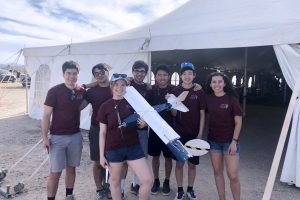
The Johns Hopkins University Design, Build, Fly team placed 17th out of 101 universities in the 24th annual American Institute of Aeronautics and Astronautics Design Build Fly (AIAA DBF) competition.
The AIAA DBF competition challenges engineering students to design, build, and fly an unmanned, electric powered, radio controlled airplane which can best meet a specified mission that changes every year. This year, 143 teams from 14 countries applied to compete in the event, with only 101 making it to the final phase.
The challenge was to build a banner towing bush plane with a 5-foot maximum wing span. The competition encompassed three main missions that included a test flight, a charter mission with passengers and luggage (simulated by wooden blocks), and a banner flight, where they had to deploy a banner after take-off and release the banner before landing.
The competition usually includes two components—a fly-off and a formal report. Originally scheduled for April 16–19 in Wichita, Kansas, this year’s fly-off was cancelled to safeguard the health of the teams due to the coronavirus pandemic. Teams were scored only based on their design reports, submitted in February. Many teams also submitted videos of them flying their aircraft at home. (Watch the team’s test flight below)
The team was disappointed that they wouldn’t be able to fly in Kansas, especially because they had been running ahead of schedule.
“For the seniors, the fly-off was going to be the culmination of our DBF tenure, and we’d spent the entire school year preparing for it. We knew we had a good shot at a strong performance,” said mechanical engineering major Tyler Spoleti, team lead and a member of the Class of 2020. “We had our entire plane solution completed before campus shut down. We flight tested all capabilities of the plane by Feb 16th, our earliest completion date yet.”
A total team of 25 students – including undergraduates from mechanical engineering, computer science, and electrical and computer engineering – worked together on the aircraft. Tamer Zaki, associate professor of mechanical engineering, is the team’s faculty advisor.
During the fall semester, the group split into four independent design teams that each created an aircraft for an internal mock competition, with the best aspects of each design incorporated into the competition design. For the spring semester, small teams worked on different subsystems of the final aircraft. They used award money from the Whiting School’s Student Initiative Fund for the prototyping process.
“What I enjoyed most this year was exploring plane design ideas we’ve never tried before, such as the use of multiple motors, modular construction, and a heavy reliance on plastics and composites for main structural components,” said rising junior Alan Huang. “I’m excited to build upon everything we learned this year about plane design and team management, and see how our plane performs at next year’s competition.”
The final aircraft featured two innovations for the team: a plastic rail body and the use of two propellers. In the past, their planes had been made entirely from wood, which is cheap and lightweight but not as easy to modify. In contrast, the plastic rail body enabled them to use nuts and bolts to attach aircraft components, which made everything modifiable. The use of two propellers provided the aircraft with more thrust, decreasing lap times and increasing points scored in the competition.
One of the key design challenges was stowing, towing, and releasing the JHU banner midflight, without affecting the aircraft’s ability to fly. The banner team, led by Zooey He ’20, tested the banner system on a bicycle in the Wyman Park Building parking lot – a great example of the team’s resourcefulness and creativity, said Spoleti.
In all, the team was happy with the results. The 17th place finish was a program-best for the Hopkins DBF chapter, which has been competing in the event since 2011.
“I’m really proud of our finish and how the underclassmen stepped up this year. The seniors have done a lot of pioneering in engineering, project management, recruiting, fundraising, and budgeting to get the team this far. This was a breakout year for the team, and it went much smoother thanks to the contributions of our underclassmen. I know the team is well-equipped with the tools needed to continue this year’s success in the years to come,” said Spoleti.
To learn more about Hopkins DBF, visit their website, Facebook page, or email [email protected]